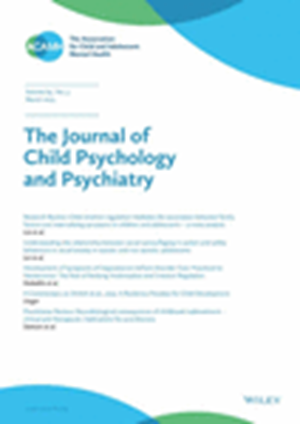Sex-specific pathways from early irritability trajectories to later suicidal ideations and behaviors: Findings from the ABCD study®.
IF 7
1区 医学
Q1 PSYCHIATRY
引用次数: 0
Abstract
BACKGROUND Previous studies have demonstrated that children with high irritability are at increased risk for suicidal ideations and behaviors. However, they have mostly relied on teacher reports and shown mixed findings regarding sex differences. We aimed to identify developmental trajectories of childhood irritability, test their direct and indirect (through psychopathology) associations with adolescent suicidal ideations and behaviors, and examine whether these associations differed by sex. METHODS This study used five waves of data from the adolescent brain cognitive development (ABCD) Study (N = 4,583). Parents rated their children's irritability yearly from ages 9-10 to ages 11-12, internalizing (e.g. depression) and externalizing (e.g. aggression) symptoms at ages 12-13, and suicidal ideations and behaviors (SIBs) at ages 13-14 using the child behavior checklist. Subgroups of irritability trajectories were derived using growth mixture modeling. Path analysis was conducted to test the total, direct, and indirect pathways from irritability trajectories to SIBs through internalizing and externalizing symptoms, and sex differences in those paths. RESULTS Four irritability trajectories were identified: low-stable (73.01%), rising (12.04%), declining (10.28%), and high-stable (4.67%). Compared with the other trajectories, children on the high-stable irritability trajectory were at higher risk for suicidal ideations (β = .13, p < .001), directly (β = .03, p = .04) and indirectly through internalizing and externalizing (β = .04 and 0.05, respectively, p's < .001) symptoms. Sex differences emerged for the rising and declining trajectories: pathways to suicidal ideations were mainly mediated by internalizing symptoms in females and externalizing symptoms in males. Pathways from all irritability trajectories to suicidal behaviors were mediated by internalizing and externalizing symptoms and were stronger in females than males. CONCLUSIONS Distinct trajectories of parent-reported irritability in childhood are differentially associated with suicidal ideation and behavior in adolescence, with the high-stable trajectory conferring the greatest risk. Internalizing and externalizing symptoms play key mediating roles, with notable sex differences in children following rising and declining irritability trajectories. Females with high irritability at any time point in preadolescence were at particular risk for suicidal behaviors.从早期易怒轨迹到后来的自杀意念和行为的性别特异性途径:来自ABCD研究的发现。
背景先前的研究表明,高易怒的儿童有自杀意念和自杀行为的风险增加。然而,他们主要依赖于教师的报告,并在性别差异方面显示出复杂的发现。我们的目的是确定儿童易怒的发展轨迹,测试其与青少年自杀意念和行为的直接和间接(通过精神病理学)联系,并检查这些联系是否因性别而异。方法采用青少年大脑认知发展(ABCD)研究的5波数据(N = 4583)。父母在9-10岁至11-12岁期间每年对孩子的易怒程度进行评分,在12-13岁期间对孩子的内化(如抑郁)和外化(如攻击)症状进行评分,在13-14岁期间对孩子的自杀意念和行为(sib)进行评分。使用生长混合模型推导出易怒轨迹的亚组。本研究采用通径分析方法,通过内化和外化症状检验易怒轨迹到sib的总、直接和间接通路,以及这些通路的性别差异。结果共发现低稳定型(73.01%)、上升型(12.04%)、下降型(10.28%)和高稳定型(4.67%)4种易怒轨迹。与其他轨迹相比,高稳定易怒轨迹的儿童有更高的自杀意念风险(β =。13、p <。001),直接(β =。3、p =。04)和间接通过内部化和外部化(β =。p < 0.05, p < 0.05。001)症状。上升和下降的轨迹出现了性别差异:自杀意念的途径主要由女性的内化症状和男性的外化症状介导。从所有易怒轨迹到自杀行为的途径都是由内化和外化症状介导的,并且女性比男性更强。结论童年时期父母报告的不同易怒轨迹与青少年自杀意念和行为存在差异,且高稳定轨迹的自杀风险最大。内在化和外在化症状起着关键的中介作用,儿童在烦躁情绪上升和下降的轨迹上存在显著的性别差异。在青春期前的任何时间点具有高易怒的女性都有特别的自杀行为风险。
本文章由计算机程序翻译,如有差异,请以英文原文为准。
求助全文
约1分钟内获得全文
求助全文
来源期刊
CiteScore
13.80
自引率
5.30%
发文量
169
审稿时长
1 months
期刊介绍:
The Journal of Child Psychology and Psychiatry (JCPP) is a highly regarded international publication that focuses on the fields of child and adolescent psychology and psychiatry. It is recognized for publishing top-tier, clinically relevant research across various disciplines related to these areas. JCPP has a broad global readership and covers a diverse range of topics, including:
Epidemiology: Studies on the prevalence and distribution of mental health issues in children and adolescents.
Diagnosis: Research on the identification and classification of childhood disorders.
Treatments: Psychotherapeutic and psychopharmacological interventions for child and adolescent mental health.
Behavior and Cognition: Studies on the behavioral and cognitive aspects of childhood disorders.
Neuroscience and Neurobiology: Research on the neural and biological underpinnings of child mental health.
Genetics: Genetic factors contributing to the development of childhood disorders.
JCPP serves as a platform for integrating empirical research, clinical studies, and high-quality reviews from diverse perspectives, theoretical viewpoints, and disciplines. This interdisciplinary approach is a key feature of the journal, as it fosters a comprehensive understanding of child and adolescent mental health.
The Journal of Child Psychology and Psychiatry is published 12 times a year and is affiliated with the Association for Child and Adolescent Mental Health (ACAMH), which supports the journal's mission to advance knowledge and practice in the field of child and adolescent mental health.

 求助内容:
求助内容: 应助结果提醒方式:
应助结果提醒方式:


